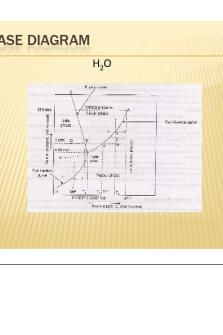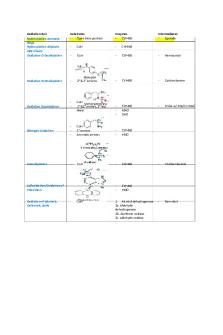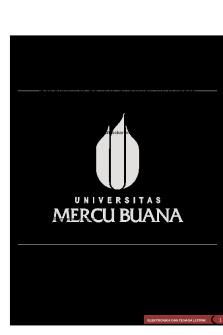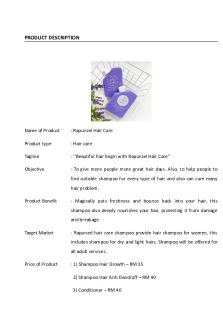Phase Transfer Catalyst PDF

| Title | Phase Transfer Catalyst |
|---|---|
| Author | Jared Kemboi |
| Course | (CHEM 2123, 2223, 2423) Organic Chemistry Laboratory |
| Institution | Texas A&M University |
| Pages | 4 |
| File Size | 121.8 KB |
| File Type | |
| Total Downloads | 18 |
| Total Views | 145 |
Summary
Phase Transfer Catalyst ...
Description
Jared Kemboi CHEM 237-518 October 25th, 2020 TA: Seokmin Kang Experiment 10: Phase Transfer Catalyst Purpose In this experiment, the purpose of the lab was to observe the use of a phase transfer catalyst to cause a SN2 reaction in a Dichloromethane solution without conducting the extraction for the product isolation. Methods used during this experiment included Thin Layer Chromatography (TLC), which is a separation technique of organic compounds. Summary of Experiment In this experiment, students identified the phase transfer catalyst and the ability to move a reactant from an aqueous to organic state in order for the reaction to take place. TLC was used to monitor the reaction which contained 2-naphthol, benzyl-tri-n- b utylammonium chloride, the catalyst which moved naphtholate anions from the aqueous to organic phase, and allyl bromide which was in the dichloromethane solution. At four time intervals of 0 minutes, 5 minutes, 15 minutes, and 30 minutes, samples from the organic phase of the mixture were taken, and were placed in a TLC jar containing dichloromethane, which ultimately led to the TLC plate being shown under a UV Light and the calculation of Rf values. Our data and observations were recorded, and are shown below, including data that was posted on Ecampus. Data and Results TLC Plate 1 TLC Sample
Rf value
(S1)- 0 minutes
0.43
(S2)- 5 minutes
0.3
(S3)- 15 minutes
0.23
(S4)- 30 minutes
0.33
Phase Transfer Catalysis Masses Pre Weighted Vial- Fraction 3
10.631g
Pre Weighted Vial- Fraction 4
10.229g
Vial and Product- Fraction 3
10.638g
Vial and Product- Fraction 4
10.232g
Percent Yield Calculation (Fraction 3) Formulas: ● Percent Yield= (Actual Amount)/(Theoretical Yield)*100= (0.007g)/(0.0736g)*100= 9.51% ● Theoretical Yield= (0.0576g of 2-naphthol) *(1mol)(1mol of allyl naphthol ether)(184.2g)/(144.2g)(1mol of 2-naphthol)(1mol) = 0.0736g ● Actual Amount= Vial+Product-Vial= 10.638g-10.631g= 0.007g
For the TLC Plate, the Rf values for S1-S4 were 0.43, 0.3, 0.23, and 0.33 respectively. The Rf values were calculated by using the formula distance traveled by solute/distance traveled by solvent, with units being in centimeters but ultimately canceling out after performing division. On Ecampus, the Phase Transfer Catalysis Masses were given, and According to Section Assignment 518-108, the masses of fraction 3 and fraction 4 vials were 10.631g and 10.229g
respectively. Furthermore, the masses of the vial + product of fraction 3 and fraction 4 were determined to be 10.638g and 10.232g correspondingly. In addition, the Percent Yield for fraction 3 was calculated, since it contained pure product unlike fraction 4. The Percent Yield was calculated by using the formulas and masses mentioned above, incorporating the molecular weights of the reactant and product to determine theoretical yield, as well as the masses given to calculate the actual amount or “actual yield”. The Percent Yield was calculated to be 9.51%. Discussion In this experiment, the main objective was to examine the effect of a phase transfer catalyst in a SN2 Reaction. Phase transfer catalysts are agents that can transfer a reactant between different phases, usually an organic and aqueous phase. The transfer catalyst for this reaction was benzyl-tri-n- b utylammonium chloride which is an ionic compound and is soluble in organic solvents. The catalyst acted to carry the naphtholate anion into the organic solvent of alkyl bromide, a nonpolar molecule, a polar 2-naphthol molecule, and dichloromethane, where the reaction can occur and produce allyl 2-naphthyl ether. When looking at our TLC data plate we can see that allyl bromide was hard to observe under the UV light, because it stayed in the dichloromethane solution and slowly evaporated, but because it is a nonpolar molecule, it was able to get through the column just a bit as compared to the rest of the molecules. As the reaction progressed, the concentration increased in size and the Rf values were generally around the same. Rf values tell us how far something moves as compared to the solution that is carrying it. Since “like dissolves like”, you would expect a polar compound to be more soluble in a polar solvent, and it will be carried further than a nonpolar compound. The larger an Rf of a compound, the larger distance it traveled on the TLC plate, and the less polar it is because it interacts less with the polar absorbent on the TLC plate, which our data successfully represented,
where S1 had the largest Rf value, since it is a nonpolar molecule. The obtained IR Spectrum, which was located on Ecampus, showed that the IR peak was 2-naphthol in fraction 3 and fraction 4. 2-naphthol was the remaining starting material, since it had a strong peak of 3058.41 cm^-1, which clearly showed the O-H stretch of the molecule. Sources of Error When performing this procedure, there could have been many sources of error possible. Onc source of error could have been stirring the mixture too quickly after it is added to the dichloromethane solution and the sodium hydroxide is added, which helped in deprotonation of the alcohols, making them good nucleophiles. If the mixture is stirred too fast, the layers won’t be able to separate properly. Another source of error could have been due to contamination within the samples provided, altering our results and data, and causing the Rf values to be skewed, altering the IR Spectrum. Conclusion In Conclusion, the objectives of this experiment were successfully met, in using a phase transfer catalyst, resulting in a SN2 reaction in dichloromethane. Thin Layer Chromatography was applied and Rf values were calculated and successfully compared with, proving that TLC is a successful method in identifying compounds and polarity differences....
Similar Free PDFs

Phase Transfer Catalyst
- 4 Pages

Catalyst
- 4 Pages

Catalyst 2960L Datahseet
- 19 Pages

Phase Rule
- 21 Pages

Phase Diagram
- 4 Pages

PS-Modules Week 6- Catalyst Reaction
- 35 Pages

Phase 1 and phase 2 reactions
- 8 Pages

TRAFO 1 PHASE DAN 3 PHASE
- 13 Pages

Corr TPHill Phase Photochimique
- 4 Pages

PHASE 1: STRATEGIC PLANNING
- 1 Pages

ERD+ Phase 1 database
- 1 Pages

Transfer Pricing.
- 27 Pages
Popular Institutions
- Tinajero National High School - Annex
- Politeknik Caltex Riau
- Yokohama City University
- SGT University
- University of Al-Qadisiyah
- Divine Word College of Vigan
- Techniek College Rotterdam
- Universidade de Santiago
- Universiti Teknologi MARA Cawangan Johor Kampus Pasir Gudang
- Poltekkes Kemenkes Yogyakarta
- Baguio City National High School
- Colegio san marcos
- preparatoria uno
- Centro de Bachillerato Tecnológico Industrial y de Servicios No. 107
- Dalian Maritime University
- Quang Trung Secondary School
- Colegio Tecnológico en Informática
- Corporación Regional de Educación Superior
- Grupo CEDVA
- Dar Al Uloom University
- Centro de Estudios Preuniversitarios de la Universidad Nacional de Ingeniería
- 上智大学
- Aakash International School, Nuna Majara
- San Felipe Neri Catholic School
- Kang Chiao International School - New Taipei City
- Misamis Occidental National High School
- Institución Educativa Escuela Normal Juan Ladrilleros
- Kolehiyo ng Pantukan
- Batanes State College
- Instituto Continental
- Sekolah Menengah Kejuruan Kesehatan Kaltara (Tarakan)
- Colegio de La Inmaculada Concepcion - Cebu



